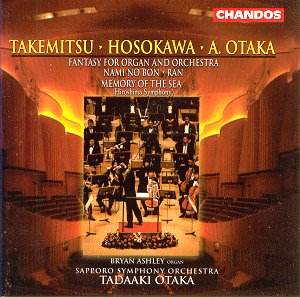Toru TAKEMITSU
Nami no Bon and Ran
Toshio HOSOKAWA
Memory of the Sea (Hiroshima Symphony) - premiere recording
Atsutada OTAKA
Fantasy for Organ and Orchestra - premiere recording
 Bryan Ashley (organ)
Bryan Ashley (organ)
Sapporo Symphony Orchestra/Tadaaki Otaka
 CHANDOS CHAN 9876
[87:41]
CHANDOS CHAN 9876
[87:41]
Crotchet
AmazonUK
AmazonUS

This album contains four works by three modern Japanese composers, mixing
original concert pieces with music derived from the screen. The opening piece,
Atsutada Otaka's Fantasy for Organ and Orchestra, is both the
longest of the four, and least likely to find popular favour. Atsutada Otaka
is the older brother of the conductor, making this premiere a particularly
personal event. His Fantasy is in a single movement, in this recording
lasting 28 minutes, written as a 1999 commission for the debut concert of
the new hall at the Tokyo University of Fine Arts and Music. It is an unsettled
and unsettling piece, devoid of any clearly recognisable melody or centre.
Finding any sort of focus is difficult, as passages of almost dreamlike
detachment alternate seamlessly with sequences of distant and austere menace.
The organ, in a part demanding unflamboyant virtuosity from Bryan Ashley,
is a remote yet unforgiving anchor, around which the orchestra quests, individual
solo lines evaporating before making any certain mark. This is music which
now sounds old-fashioned. While not broaching anywhere near the unfriendly
extremes of rampant 50s and 60s serial/12-tone writing, its lineage can be
traced in that direction. It is, like a nebulous bad dream, a work which
lingers on the edge of memory without ever suggesting why it should be
remembered, haunted in its own lack of resolution.
The centre of the album is made-up of two screen-derived works by the late
Toru Takemitsu, noted both for his concert and film music. Few in
the West will ever have heard of Nami no Bon, a Japanese television
drama about 'conflict between first and second generation Japanese-Hawaiians
during the Pacific War.' The suite here is in six movements lasting 18 minutes.
There is nothing obviously 'Japanese' or 'Hawaiian' about any of this music.
Given the wartime setting one might be expect excitement and action, but
instead the music is elegantly nostalgic and wistful centred around two beautiful
main themes. The resigned heartbreak of 'Tray of Waves', imaginatively
orchestrated with delicate chimes and lovely woodwind, suggests a restrained
version of classic 1950s Hollywood, whilst the sheer lyricism of 'Faded Letter'
is proof, if any were needed, of this composer's poignant sensibilities.
'Misa's Theme' can stand as a monument to the power of understatement, as
indeed can the painfully bittersweet 'Finale', with only 'Shadow of Night'
offering more conventional suspense writing.
More obvious conflict arises in the almost 12 minutes of music by Takemitsu
derived from Akira Kurosawa's celebrated Ran (1985), a translation
of King Lear to medieval Japan. This is an epic film, though the music here,
while implicitly martial, does not suggest the scale of Hollywood's approach
to such matters. Here, in these four numbered, untitled movements, is a simmering
stone-dry tension. The first three cues; a fatalistic string theme strides
with slow stoicism through interruptions from distant brass; a wind machine
echoes the finale of Vaughan Williams' score for Scott of the Antarctic
(1948), met with a lone bell and deep, brooding strings; timpani beat the
gathering of forces, a horn calling a lament. The final cue, longer than
the first three at over six minutes, is a portrait of defeat and despair,
anguish and implacable horror with a very human face. This, though the notes
do not tell us, is the finale, the aftermath; music as coruscating as any
film music in recent memory.
Another premiere recording, Memory of the Sea (Hiroshima Symphony)
by Toshio Hosokawa, ends the programme. It is a single movement work
lasting just under 20 minutes. Hosokawa was born in 1955 and grew-up in
Hiroshima, his aim here to write a piece which paid homage to the recovery
of the city in the aftermath of the atomic bomb, to the beauty of the countryside
and to the invisible power of nature. It is a glittering, richly orchestrated
paean, filled with mercurial wonderment riven with tension, light and fire
flashing through the percussion with a tumultuous spirit; as if perhaps Bax
and Scriabin had joined forces to unleash a new Prometheus. It is not, by
normal Western definitions, a symphony nor even a symphonic poem, but whatever
it is, it is spellbinding. In live performances two groups of banda
(musicians playing apart from the main orchestra) move around the hall, creating
a three dimensional effect). By moving the musicians at various times in
the recording, an attempt has been made to replicate this effect. While obviously
difficult to recreate through two speakers, the CD certainly offers a vivid
kaleidoscope of sound.
Given the sheer constancy and quality of Chandos recordings, one barely need
mention that this is a first-rate production, stunningly recorded by producer
Tony Harrison and engineer Mike Hatch. The booklet is thoroughly informative,
and the only thing we are left wondering is when Nami no Bon was made.
This is a contrasting selection of works which has something to offer devotees
of concert hall and film music alike. Those willing to embrace the heady
flowers of the new will be enthralled by the rapturous Memory of the
Sea. While not to all tastes, an imaginative and rewarding release, and
at almost 79 minutes outstanding value too.
Gary S. Dalkin

